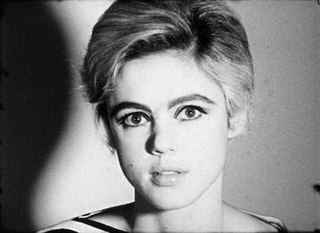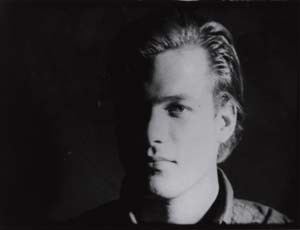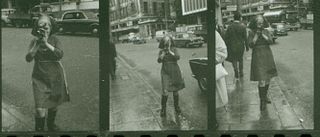
Edith Minturn Sedgwick Post was an American actress and fashion model who was one of Andy Warhol's superstars, starring in several of his short films during the 1960s. Her prominence led to her being dubbed an "It Girl", while Vogue magazine named her a "Youthquaker".
Warhol superstars were a clique of New York City personalities promoted by the pop artist Andy Warhol during the 1960s and early 1970s. These personalities appeared in Warhol's artworks and accompanied him in his social life, epitomizing his dictum, "In the future everyone will be famous for fifteen minutes". Warhol would simply film them, and declare them "superstars".

Ciao! Manhattan is a 1972 American avant garde film starring Edie Sedgwick. A scripted drama in which most of the actors play themselves, it centers on a character very closely based on Sedgwick and deals with the pain of addiction and the lure of fame.

The Factory was Andy Warhol's studio in New York City, which had four locations between 1963 and 1987. The Factory became famed for its parties in the 1960s. It was the hip hangout spot for artists, musicians, celebrities and Warhol's superstars. The original Factory was often referred to as the Silver Factory. In the studio, Warhol's workers would make silkscreens and lithographs under his direction.
Poor Little Rich Girl is a 1965 underground film by Andy Warhol starring Edie Sedgwick. Poor Little Rich Girl was conceived as the first film in part of a series featuring Sedgwick called The Poor Little Rich Girl Saga. The saga was to include other Warhol films: Restaurant, Face, and Afternoon.

Factory Girl is a 2006 American biographical film directed by George Hickenlooper. It is based on the rapid rise and fall of 1960s underground film star and socialite Edie Sedgwick, known for her association with the artist Andy Warhol.

The Screen Tests are a series of short, silent, black-and-white film portraits by Andy Warhol, made between 1964 and 1966, generally showing their subjects from the neck up against plain backdrops. The Screen Tests, of which 472 survive, depict a wide range of figures, many of them part of the mid-1960s downtown New York cultural scene. Under Warhol's direction, subjects of the Screen Tests attempted to sit motionless for around three minutes while being filmed, with the resulting movies projected in slow motion. The films represent a new kind of portraiture—a slowly moving, nearly still image of a person. Warhol's Screen Tests connect on one hand with the artist's other work in film, which emphasized stillness and duration (for example, Sleep and Empire, and on the other hand with his focus after the mid-1960s on documenting his celebrity milieu in paintings and other works.

Vinyl is a 1965 American black-and-white film directed by Andy Warhol at The Factory. It is an early adaptation of Anthony Burgess' 1962 novel A Clockwork Orange, starring Gerard Malanga, Edie Sedgwick, Ondine, and Tosh Carillo, and featuring such songs as "Nowhere to Run" by Martha and the Vandellas, "Tired of Waiting for You" by The Kinks, "The Last Time" by The Rolling Stones and "Shout" by The Isley Brothers.

a, A Novel is a 1968 book by the American artist Andy Warhol published by Grove Press. It is a nearly word-for-word transcription of tapes recorded by Warhol and Ondine over a two-year period in 1965–1967.

Paul Johnson, better known as Paul America, was an American actor who was a member of Andy Warhol's Superstars. He starred in one Warhol-directed film, My Hustler (1965), and also appeared in Edie Sedgwick's final film Ciao! Manhattan (1972).
Chuck Wein was an American promoter and manager of entertainment acts whose celebrity stemmed from his five-year (1964–1969) association with Andy Warhol and from his discovery of Edie Sedgwick who became a Warhol superstar of 1965. He was also a film director.

Beauty No. 2 is a 1965 American avant-garde film by directed by Andy Warhol and starring Edie Sedgwick and Gino Piserchio. Chuck Wein also has a role in the film but never appears onscreen. Wein wrote the scenario and is also credited as assistant director.
Bima Stagg - May 3, 1945 - October 21, 2021Bima Stagg was an American writer and filmmaker living in Los Angeles, California.
Eugene "Gino" Piserchio was an American actor, composer and musician. Piserchio was noted for being an accomplished musician. He was one of the first musicians to master the Moog synthesizer.
Kitchen is a 1966 feature-length underground film directed by Andy Warhol and Ronald Tavel, and starring Edie Sedgwick, Rene Ricard, Tavel, Roger Trudeau, David McCabe, Donald Lyons, and Electrah. The entire film takes place in the New York City kitchen of Bud Wirtschafter, the sound man.
The Andy Warhol Story is a 1966 underground film directed by Andy Warhol with cinematography by Paul Morrissey, and starring Edie Sedgwick and Rene Ricard.
Space (1965) is an underground film directed by Andy Warhol, written by Ronald Tavel, and starring Edie Sedgwick, Gino Piserchio, Dorothy Dean, Ed Hennessey, singer-songwriter Eric Andersen, and Norman Levine. Unlike many of Warhol's other films made at The Factory, this film involved a moving camera, moving around the actors as they stood still.
Horse is a 1965 underground film directed by Andy Warhol, written by Ronald Tavel, and starring Edie Sedgwick, Gregory Battcock, Tosh Carillo, Ondine, Norman Glick, Daniel Cassidy Jr., and Larry Latrae (Latreille). Warhol makes a cameo.

Barbara Rubin (1945–1980) was an American filmmaker and performance artist. She is best known for her landmark 1963 underground film Christmas on Earth.

My Hustler is a 1965 American film by Andy Warhol, and Paul Morrissey. The film is propelled by the sonorous, magnetic acting of 30-year-old Ed Hood interacting with the blonde Hustler, Paul America.










